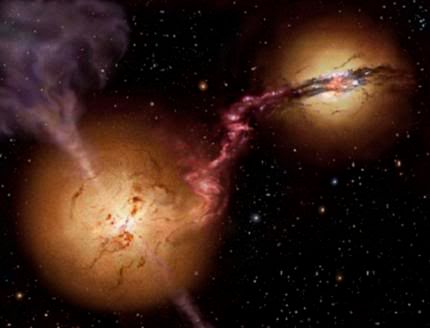Post by glactus on Sept 28, 2009 6:22:45 GMT

galaxies in collision
New observations made with the Submillimeter Array of eight radio antennas atop the extinct volcano on the island of Hawaii suggest that black holes – thought to exist in many, if not all, galaxies – were common even in the early Universe, when galaxies were just beginning to form. Astronomers have found two very different galaxies in the distant Universe, both with colossal black holes at their heart, involved in a spectacular collision.

The array at Mauna kea. Hawaii
4C60.07 – the first of the galaxies to be discovered – came to astronomers’ attention because of its bright radio emission. This radio signature is one telltale sign of a quasar – a black hole, spinning rapidly, feeding on its parent galaxy.
A new image captures the moment, approximately 12 billion years ago, when this galaxy ripped a stream of dusty gas from a neighbour.
When 4C60.07 was first studied, astronomers thought that gas surrounding its black hole was undergoing a burst of star formation, turning virgin gas into stars at a remarkable rate - the equivalent of 5,000 of our suns every year.
"This new image reveals two galaxies where we only expected to find one," said Professor Rob Ivison at the Science and Technology Facilities Council’s UK Astronomy Technology Centre in Edinburgh, lead author of the study that will be published in the Monthly Notices of the Royal Astronomical Society.
"The superb resolution of the Submillimeter Array was key to our discovery," said Steve Willner of the Harvard-Smithsonian Center for Astrophysics, a co-author of the paper. "These two galaxies are fraternal twins. Both are about the size of the Milky Way, but each one is unique."
Dr Glenn Morrison, an astronomer at the Institute for Astronomy and the Canada-France-Hawaii Telescope in Hawaii, added “Understanding the prevalence of black holes in the early years of the Universe will rely on combining information from across the whole electromagnetic spectrum”.
Credits: The UK Technologies facility council
www.stfc.ac.uk/


